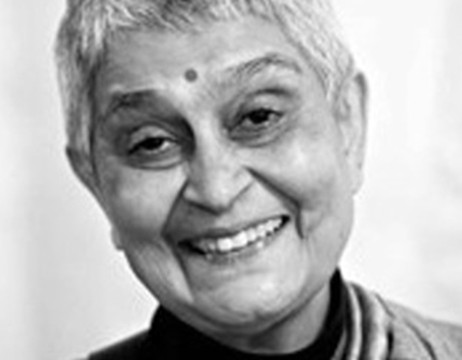Click below icon to Subscribe to Modlingua Channel
Research

- posted by: Ravi Kumar
-
Hits: 3895
By Ravi Kumar
A significant statement on “The Politics of Translation” comes from Gayatri Chakravorty Spivak (1993/2004) who considers translation as an important approach in pursuing the larger feminist agenda of achieving women's `solidarity'.
The seminal essay, “The politics of translation” brings together feminist, postcolonialist and poststructuralist approaches. Through various examples, she highlights the tensions between different approaches and calls for the surrender of self by the translator to the text. As a translation, itself is reading, and one of the best ways to get around the confines of own’s identity is to work with someone else’s title. She further relates this act with a language that belongs to many others, “this, after all, is one of the seductions of translating”. She further explains that the task of the feminist translator is to consider language as a clue to the working of the gendered agency.
As a translator Spivak is fully aware of the challenges one faces while translating, therefore, she understands why one tends to play safe by siding with logic over rhetorical inferences, but she explains that in doing so, one loses vital clues hidden in the source text. To decipher these metaphors which get lost in between source to translated text, she calls for the development of love and affinity to the text by the translators. Thus, the task of the translator is to facilitate this love between the original and its shadow, a love that permits faying holds the agency of the translator and the demands of her imagined or audience at bay.
Spivak is concerned with the politics of translation from a non-European woman’s text, as too often the translator fails to engage with, or care insufficiently for the rhetoricity of the original. While trying to portrait something meaningful translator ends up creating menace of space outside language. This is most eerily staged (and challenged) in the effort to communicate with other intelligent possible being in space. (Absolute alterity or otherness is thus differed-deferred into another self who resemble us, however minimally, and with whom we can communicate.
Based on the ideas proposed by post-structuralists like Derrida, Spivak wants to deconstruct the preconceived thought processes that she sums up in terms of the three-tiered notion of language: rhetoric, logic, silence, she proposes a different kind of effort for translation in terms of synonym, syntax and local color. She justifies Derrida when he points out the difficulties between French and English, and agrees to speak in English—" I must speak in a language that is not my own because that will be more just"—I want to claim the right to the same dignified complaint about a woman's text in Arabic or Vietnamese”.
Perhaps, this idea helps her to challenge the English language dominated feminists movements which through the law of majority not only silences the minority language feminists within the western world but the same concept is imposed upon in other poor countries of Asia or the Arab world. “In the act of wholesale translation into English, there can be a betrayal of the democratic ideal into the law of the strongest”.
Spivak speaks out against Western feminists who expect feminist writing from outside Europe to be translated into the language of power, English. Such translation, in Spivak's view, is often expressed in 'translationese', which eliminates the identity of politically less powerful individuals and cultures. She suggests that feminists from the hegemonic countries should show real solidarity with women in postcolonial contexts by learning the language in which those women speak and write.
She also says that one's first responsibility in understanding solidarity is to learn other women's mother tongue rather than consider solidarity as an `a priori' given. Spivak also shows a kind of anxiety for the ‘Third World' illiterate women and the first task of the feminists is to learn their language rather than impose someone's notion of solidarity and feminism on them. ` There are countless languages in which women all over the world have grown up learning and have been female or feminist, and still the languages we keep learning the most are the powerful European ones, sometimes the powerful Asian ones, least often the chief African ones.
Translation for Spivak is an act of understanding the other as well as the self. For her, it has a political dimension, as it is a strategy that can be consciously employed. She uses the feminine adjectives like submission, intimacy, and understanding for theorizing translation. Thus theorizing translation itself receives a feminist slant.
In Spivak's opinion, the 'politics of translation' currently gives prominence to English and the other 'hegemonic' languages of the ex-colonizers. Translations into these languages from Bengali too often fail to translate the difference of the Bengali view because of the translator, albeit with good intentions, over-assimilates it to make it accessible to the Western readers.
Spivak's work is indicative of how cultural studies, and especially post-colonialism, has over the past decade focused on issues of translation, the transnational and colonization and translation has been manipulated to disseminate an ideologically motivated image of postcolonial countries.
Thus we notice that Spivak has dismantled the pre-conceived notion of feminism as well as thoughts revolving around post-colonial literature and society through English. Her approach appears to be quite harsh for the feminist writers but certainly, it helps feminist writers to understand the rhetoric of language and culture, and women of post-colonial countries will be able to speak more freely and share their inner problems in a more open way if they learn their language. This will also increase historical, social-cultural, ideological and political understanding of the society about which the western feminists have been showing solidarity from the outer periphery through hegemonic English psyche.
Spivak is supported in parallel by feminist theorists who have spoken against the male-driven depiction of translations and of women. Such orientations have been linked to colonial thought processes where the colony is considered as translational copy whose suppressed identity has been overwritten by the colonizer. Translation's role in disseminating such ideological images has led Bassnett and Trivedi (1999: 5) to refer to the 'shameful history of translation'.
Note: Gayatri Chakravorty Spivak (24 February 1942- ) is Professor at Columbia University, USA. She is a founding member of the Institute for Comparative Literature and Society at Columbia University. B.A. English (First Class Honors), Presidency College, Calcutta, 1959. Ph.D. in Comparative Literature, Cornell University, 1967. D. Litt, University of Toronto, 1999; D. Litt, University of London, 2003; D. Hum, Oberlin College, 2008. D. Honoris Causa, Universitat Rovira I Virgili, 2011, D. Honoris Causa, Rabindra Bharati, 2012, The 2012 Kyoto Prize Laureate in the field of Arts and Philosophy.
- posted by: Shubham singh
-
Hits: 2554
Talk presented by Dr. Vashini Sharma
Video Summary by Shubham Singh
Across the world, the most interesting factor that exists is intercultural communication. But communicating interculturally has a bigger dimension attached to it. The main aspect of focus in this video is of cross-cultural interaction.
Dr. Vashini Sharma who is the speaker in this video explains that cross-cultural communication through watching animated shows is connecting people with the theme of an idea. It tries to grasp the cultural differences and create a content to which people can relate to. Interestingly the context of communication in this regard depends on communication with language and/or with actions as far as the viewer’s understanding is considered. The success of communication relies on the extent of the message conveyed through the medium. This is where transcreation comes in, which bridges the language barrier and ensures better communication and transfer of content in a subtle manner which is easier to understand.
For those who aren't aware of this term, transcreation refers to an exchange of language or translating a language with the aim to produce the same theme and content as of the previous one.
In the video, one can see an example of cartoons being translated for children. Also, some of the shows don’t include usage of verbal communication but the actions with an aim of expressing emotions to the viewers and generate reactions.
The aspects that have been covered in the video show:
- •The value of Transcreation that links people or groups from different cultures together. It removes the language barrier and provides a scope for the exchange of ideas and concepts.
- •Transcreation has more to do with localization of language for the people living in a particular region. Vaishnavi Sharma shows the example of Indian idioms used in cartoons like Sinchan, which is common in India and is viewed by the majority of children. Every dialogue is relatable to the culture that people usually do.
- •Thirdly a transcreated product intends to showcase the content appropriately. This further leads to the implementation of ideas that one can think or implement upon viewership. Children learning cartoon songs which are trans scripted in Hindi is a peculiar example. Also the moral at the end of a cartoon for children makes them learn something new, which is implemented.
- •The video concludes with the development of the cross-cultural sector. More employment is generated for translators and interpreters which requires skill. The growth of this industry is proceeding and showing better results.
Hence transcreation is not only a language interchange, but it also involves various other facets like cultural linking and relationship building. It also brings in the visualization factor into being which comes in along with familiarity with the language. It can also be used to bring in wit and humor in a native sense.
- posted by: Ravi Kumar
-
Hits: 2694
By Prof.Ramadhikari Kumar, Rector, Jawaharlal Nehru University
Prof.Ramadhikari Kumar who has been the pioneer of conference interpreting education in India describes the opportunities that exist in the field of translation. In order to increase the profile of translators and harness the potential that exists in India for translation professionals, he emphasizes upon the need for creating a pool of well connected and well trained human resources who are dedicated to providing quality services and using professional standards and practices.
Given that translation enables the globalization as well as localization of software and other products, he explains how the translators play a key role in the knowledge economy.
Prof. Kumar has been one of the Founder Pillars of Jawaharlal Nehru University, he has been consistently writing books and articles on topics of Russian grammar and Translation, interpretation. He has published a good number of teaching materials and guided more than a dozen research scholars at P.hD level.
He has been working towards developing and consolidating interpretation as a discipline and has since long been conducting courses on simultaneous interpretation at the Centre of Russian Studies, School of Language, Literature and Culture Studies at Jawaharlal Nehru University, New Delhi.
- posted by: Ravi Kumar
-
Hits: 2913
- posted by: Deepasri
-
Hits: 3549
Problems of interpreting in the tourism sector: Interaction with Veena Krishnamurthy
Executive Summar by Deepasri
Ravi Kumar commences the segment by thanking Veena for a wonderful presentation on the problems of interpreting in the tourism sector. He mentions how challenging it is for any newcomer to the field to cope with the language, cope with situations, new tourists, and new knowledge; all at the same time happening simultaneously. The person who does not give up survives and those who give up never come back into interpreting activity at all. So linguists should understand this.
He mentions that a lot of points come to the picture, especially the one related to training programs specifically for interpretation. Unfortunately, except for one or two universities, there are not enough facilities available, there aren’t many labs, and there is a scarcity of trainers. Thus in spite of being from a language background, people are not able to take up interpretation as a profession. People end up doing a lot of experiments that result in unprofessional behaviour and creates a bad impression of the language profession and the interpreter’s’ community. So keeping this scenario in mind Ravi Kumar refers to the session to be very informative and helpful in that aspect.
Then he opens the floor for an interactive session with Veena so that people can put forward their questions on the topic. He adds that people might not be from interpretation background but later through Modlingua Youtube Channel and community learning program he would like to share some videos on the same. He also mentions that recently they had done a successful training program on interpretation for Zee News. Now they have ten highly trained interpreters trained by him; which had been a good project for him. He would like to put up those videos on the channel but that would take time.
The first question comes from Ms. Jaya, German Trainer. She emphasizes the category where the interpreter is a local one and the tourist comes from another culture. She says that while interpreting they never translate the word, they keep it as it is; for example ‘Chapati’ and as it has its cultural meaning in India so it is not possible to translate it into an English word or in any other language. Jaya asks in this case what kind of interpretation or translation should an interpreter look for. Veena suggests retaining the word in the native language and explaining the process of its preparation or drawing reference of a similar substance from the tourist’s culture so that he is able to relate to it. So the understanding of the substance would come to the interpreter’s rescue. So the tour guide might not have mentioned that but the interpreter would need to give that explanation. If the interpreter does not have a knowledge regarding that substance he could liken it to something relatable to the tourist, like a pizza base.
Gargi comes up with the next question where she enquires if the visitors would show some cooperation to the interpreter who gets stuck somewhere so that he does not feel hopeless. Veena says that these situations are very unpredictable; normally tourists are very sweet, they do not generally want to trouble the interpreter they just want to know the culture. This is not like simultaneous interpretation where one must have his background information about the topic; one cannot get away with saying something that is not correct. But in the case of consecutive interpretation, one has time and people are generally friendly. Veena shares one experience where she had done an interpretation for an adoption process for which she had to do a lot of reading and background preparation. She had a relevant technical dictionary to make sure that she had her technical terms correct. Apart from this preparation, there was the human side where she had to communicate on the social side, where things were familiar but there were things that she didn’t know but people were cooperating and they gave her the time to look it up in case she did not get something. So even though each person is different mostly they are cooperating.
Gargi also asks that if during simultaneous conference interpretation one does not get a word then what should be done. Veena replies that generally there are people who take terms, so probably the interpreter could quickly ask the person next to him or mostly the context is given to the interpreter beforehand and he needs to do his homework completely well in case of simultaneous interpretation. In case of consecutive background information is not available beforehand and it throws up unexpected challenges for the interpreter.
Another man asks how an interpreter with deal with a batch where there isn’t just one particular culture group with one interpreter, but there is a multi-cultural group from multiple language backgrounds. Veena shares that what she has seen is that when there is a big group, divisions into subgroups are made on the basis of language. So each group goes with the interpreter of that particular language. So if there is a multi-linguistic group with just one guide, they need to have a common language otherwise it is going to be quite challenging. There the interpreter should be able to set the expectations and tell them that this is something he is not prepared for and tell them that they should be ready for a scenario where he might not be able to explain certain things in some other language. For an instance, if one is doing an interpretation of a group there is one German, one Italian and one Portuguese and there is a German interpreter. In that case, it would not be possible for the German interpreter to know Italian or Portuguese, nor will it be possible for him to research in the given time and become a linguist overnight with a B2, C1 level proficiency. So the interpreter would have to clarify that he would interpret in the language he is supposed to and for the rest, he might be interpreting in a common language such as English.
He further enquires if there could be courses on tourism interpretation in the association of institutes and the help of the Ministry. Veena states that when one talks about the Ministry it gets centered around Delhi, which is the biggest challenge. If it could be done in different states and different regions so that people would get all the information around India and they are able to interpret wherever they are. She hopes they soon some way is found out to deal with this huge challenge in India.
Swastika enquires if cultural emersion is the sole way to develop language proficiency. Veena mentions that cultural emersion teaches you about the culture, behavioural patterns, but a language is the means to explain and communicate with another person so a combination of both is required.
Nicoletta shares that everything in the session was totally clear to her and she could relate to the problems discussed in there because they had been called for guiding some groups. For instance in Sardinia, which is very different from other Italian regions, she had to explain in details what certain words meant. She thanks Veena and expresses her delight to be able to participate in the session.
In end, Ravi Kumar recalls his experience as a tourist guide during his undergraduate course. Every interaction with a new tourist was a new learning experience for him. He narrates a story of an elderly lady from Spain who had visited India earlier and had hired a taxi driver at that time to take her around and play a guide’s part as well. He had taken her to various places and after seven days she realized that the taxi driver was cheating her, by taking her to shop and taking commissions and persuading her into spending more. She went back to her country with a very bad notion.
So the next time she visited India she has to carry that fear and prejudice with her. When she interacted with Ravi she assumed he was the same kind person who would also cheat her. So it took him seven painful days to convince her that he would not cheat her, So Ravi questions Veena to suggest how newcomers can deal with such prejudices. Veena utters that it had never happened to her personally but she has heard about these kinds of scenarios from other people. What she suggested was to tell the tourist that no two people are the alike, not even the tourists that are coming to visit and just because one had cheated them before does not mean the next one will do the same. Plus on accredited interpreter will hold more credibility compared to a non-accredited one.
Ishan enquires about career opportunities after masters in interpretation. Veena suggests that one needs to equip themselves in the language in which they will be interpreting and it is also important to check if one knows the other language equally well. Since English is one of the most important languages through which one interprets it is also necessary to test if one is equally good at English as well. After bilingual proficiency, it is important to get certified in interpretation. Once these are done there will be plenty of opportunities.
With that final question, the interactive session closes and Veena concludes by mentioning that this is one of the most interesting professions and one gets to meet so many different kinds of people and every person gives you a unique experience which is a different one every day. One gets to discover their culture, another person’s culture and then when they go to a third place the multilingual aspect comes in and that makes it a wonderful experience. Of course, it has its challenges but if one sticks on they go higher and higher. Then She thanks Ravi Kumar and everyone else for their patience and the lovely opportunity of speaking in front of everyone.
- posted by: Madhu shree Dwivedi
-
Hits: 2573
Presentation by Ms Veena Krishnamurthy
Creative Summary by Madhu Shree Dwivedi
How to handle localization problems while doing consecutive interpretation in the context of tourism. A brief introduction: she is an expert for French and English, an IELTS trainer and one of the certified trainers also a versatile linguist. She had her venture called "liveguru" an online training program for languages from Chennai.
She shared about how tourist guide and interpreters face problems while explaining the local or very regional touch of culture or society or a language or situations. How these problems are tackling cross-cultural elements called third space (literal and sense to sense interpretation). She shared about the "Impact of multilingualism in interpretation especially in the tourism industry and above all in Indian context".
Firstly talking about the difference between bilingual and multilingual interpretation and secondly about how it impacts the quality of interpretation finally the effect it has on the listener.
Bilingual means when a tour guy and the interpreter both come from the same linguistic background both speak the same languages and they are in a locale which is familiar to both of them. They understand the place the kind of interpretation that is going to happen and when the interpretation happens they are sort of prepared for it they know what exactly has to be shared so there are no surprises.
Whereas when you look at the multilingual interpretation it is something that throws up many obstacles many unexpected challenges. Different multilingual context and the problem faced, there can be four scenarios and its impact on interpretations. There will be a tour guide, an interpreter, and a visitor. In the first scenario the tour guide and interpreter are from different linguistic background there is a lot of difference in their language. For example, one speaks English and the other speaks Telugu and the common language between them is English.
In this case, the language is not very clear to the person so the interpreter is not prepared for the different words that are used by the tour guide so he passes on the message to the visitor it might come out as something different from what was intended.
In the second scenario tour guide and the interpreter are from the different cultural background and probably speaks the same language. They grew up with their own customs and traditions and are unaware of what happens at the other place. Here if they are not aware of the culture that is being discussed or if they are influenced by their own culture, when they pass on the message to the visitor the information that goes out is a wrong one and if the visitor knows something about it then he understands that there is something that is being said is not correct.
The third scenario can be the tour guide is from a different cultural background whereas the interpreter is a local person the interpreter knows everything about the place but the tour guide has come from the different place.
If the tour guide is saying something which is not correct about the local place whereas the interpreter knows the correct information that has to be shared then that could create a problem between the two of them and that could impact their final output to the visitor and also the relationship between them.
The fourth scenario can be the tour guide is local whereas the interpreter is to form the different cultural background. In this case, the tour guide is trying to explain something about the place but the interpreter has absolutely no idea about it so they again pass on the wrong information or they delete it, they don't bother to interpret that part at all.
More often than not the tourist does not get the accurate information about the place, it hinders the seamless interpretation. There can be various reasons. The problem between the tour guide and the interpreter. Information is twisted and wrong information goes out. When all the that the information is not correct and only one person does not know that the information is incorrect, this creates an impact on visitor's mind that the interpreter is probably not capable of delivering correct message. The interpreter might be very good with language but doesn't have a good understanding of local tradition and culture and gives the wrong information, this could hinder the interpreter authenticity or skills or his genuineness. The tour guide may use local words and the interpreter might not have done enough research about it, as he knows only say English and not the local language so he manages to say something which is absolutely wrong.
In such situations, the interpreter loses their credibility and it can be quite harrowing for the interpreter.
How to cope up with this situation as an interpreter
- First thing is to have a recede, go to the place to look at the place mingle with the local people
- Creating a sort of data bank on probably your own experiences.
- Before the interpreter start interpreting should interact the tour guide creates a rapport with them. Spending the little time with the tour guide getting both of them to relax and treat each other as friends and not as competitors help a lot.
Lastly, there is not much training for interpretation in tourism tour guide is people who are certified but most of the interpreters are either at B-2 level. It is time took cognizance of this fact and started working on it to get a more enriching experience.





